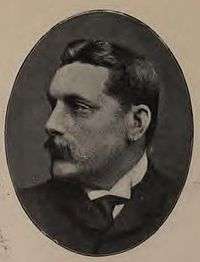Philip Hugh Dalbiac

Philip Hugh Dalbiac, CB (1855 – 28 April 1927) was a British army officer, publisher, author and Conservative Party politician.[1][2][3]
He was the third son of Henry Eadley Aylmer Dalbiac and his wife Mary (née Mainwaring), of Durrington, West Sussex.[1][2][3][4][4] Following education at Winchester College he was commissioned as a Second Lieutenant in the 70th (Surrey) Regiment of Foot in 1875,[5] but exchanged to the 45th (Nottinghamshire) Regiment of Foot in the same year.[1][6] He was promoted to lieutenant in 1879.[7] The 45th Foot became the 1st Battalion of the Sherwood Foresters in 1881, and he was promoted to captain in 1883.[8] He retired from the successor regiment, with the rank of major in 1890.[1]
Marriage
Dalbiac married Lillian Seely, fourth daughter of Sir Charles Seely of Brooke House, Isle of Wight, in 1888.[2][4] They lived in Tooting Common, South London.[3]
Political career
In June 1895 the Liberal government led by Lord Rosebery lost a vote of confidence. A general election was duly called, and Dalbiac was chosen by the Conservatives to contest the constituency of Camberwell North, which was held the Liberal Party member of parliament, Edward Hodson Bayley.[9] A third candidate, Nelson Palmer, subsequently entered the contest, claiming to be of "independent of party", but representing the labouring classes. The Conservatives secured a large majority at the election, and Bayley was one of many Liberal MPs to lose their seats. Dalbiac secured a majority of 693 votes over Bayley. Palmer's intervention had no effect, as he received only 32 votes.[10] Dalbiac only served one term in the House of Commons, choosing to step down at the next election in 1900.[11]
Although no longer a regular army officer, Dalbiac served in the part-time Volunteer Force, joining the 18th Middlesex Rifle Volunteers in 1891,[12] and was the commanding officer of the unit from 1896–1908. When the volunteers were reorganised as the Territorial Force in 1908, Dalbiac was given command of the 2nd London Divisional Transport and Supply Column, with the honorary rank of colonel.[13] He was awarded the Territorial Decoration in 1911 and made a Companion of the Bath in the coronation honours of the same year.[14][15]
Dalbiac resigned his commission in 1912,[16] but with the outbreak of the First World War in 1914 returned to the army,[17] and was given the task of forming a second line duplicate of the supply column for the newly raised 60th Division. He travelled with the new unit to Salonika, and was mentioned in despatches. A partner in the publishing company of Swan Sommenschein & Co., he became a director of George Allen & Unwin Limited in 1914.[3]
Death
Dalbiac died at Freshwater, Isle of Wight in 1927, aged 72.[1]
Publications
Dalbiac wrote a history of his former regiment, the 45th Foot, and a description of the war service of the 60th Division, which was published posthumously. He also worked on two dictionaries of quaotations.
- Dalbiac, Philip Hugh (1902). History of the 45th: 1st Nottinghamshire Regiment (Sherwood Foresters). London: Swan Sommenschein & Co.
- Dalbiac, P.H. (1908). Dictionary of Quotations (English). London: Swan Sommenschein & Co.
- Dalbiac, P.H.; Thomas Benfield Harbotle (1909). Dictionary of Quotations (French & Italian). London: Swan Sommenschein & Co.
- Dalbiac, P.H. (1927). History of the 60th Division (2/2nd London Division). London: George Allen & Unwin.
References
- 1 2 3 4 5 "Obituary: Colonel P. H. Dalbiac". The Times. 30 April 1927. p. 14.
- 1 2 3 "New Members of Parliament". The Times. 19 July 1895. p. 15.
- 1 2 3 4 "Dalbiac, Philip Hugh". Who Was Who. Oxford University Press. December 2007. Retrieved 19 May 2011. (subscription required (help)).
- 1 2 3 Lundy, Darryl (16 May 2011). "Colonel Philip Hugh Dalbiac". thePeerage.com. Retrieved 19 May 2011.
- ↑ The London Gazette: no. 24180. p. 600. 12 February 1875.
- ↑ The London Gazette: no. 24221. p. 3192. 22 June 1875.
- ↑ The London Gazette: no. 24749. p. 4806. 5 August 1879.
- ↑ The London Gazette: no. 25205. p. 1123. 27 February 1883.
- ↑ "The General Election. Metropolitan Constituencies.". Morning Post. London. 6 July 1895. p. 4.
- ↑ "The Election Campaign. Metropolitan Pollings. Increased Unionist Gains.". Morning Post. London. 18 July 1895. p. 2.
- ↑ "The General Election". The Times. 25 September 1900. p. 8.
- ↑ The London Gazette: no. 26141. p. 1268. 6 March 1891.
- ↑ The London Gazette: no. 28206. p. 9662. 18 December 1908.
- ↑ The London Gazette: no. 28506. p. 14606. 20 June 1911.
- ↑ The London Gazette: (Supplement) no. 28505. p. 4592. 16 June 1911.
- ↑ The London Gazette: no. 28607. p. 3480. 14 May 1912.
- ↑ The London Gazette: no. 28940. p. 8262. 16 October 1914.
External links
- Hansard 1803–2005: contributions in Parliament by Philip Dalbiac
- "Portrait of Philip Hugh Dalbiac by Sir (John) Benjamin Stone". National Portrait Gallery. Retrieved 19 May 2011.
| Parliament of the United Kingdom | ||
|---|---|---|
| Preceded by Edward Hodson Bayley |
Member of Parliament for Camberwell North 1895–1900 |
Succeeded by Thomas James Macnamara |